The term “political art” has implications that might well deter people from viewing it, especially here where the political is regarded as unaesthetic. It is sad that when an American artist makes “political art” it becomes news. This has been the case with the presence of political films in Cannes, as chronicled by A. O. Scott in the New York Times. He makes a parallel with the 60’s as a golden age of filmmaking, and in particular the 1968 Cannes Film Festival, where the artistic and the political were absolutely interconnected. To say that the problems we are facing today are less significant than those of the 60’s is to exchange lack of hope for the authentic belief in change that permeated that era.
The big difference today is that communications are immediate and indispensable, but that their ubiquity has also numbed us. War and catastrophe as spectacle have always fed the public imagination, but today fiction and fact, reality and artifice, have collapsed into yet another consumer product. On the other hand, the availability of affordable technology has made photography, video and filmmaking accessible to many. Now, it is possible to see interesting and good quality pieces from places far away from the established centers of film production. Cannes is still the favorite showplace of international cinema, but it doesn’t mean that many movies that make it there ever go beyond the art houses. So, the presence of Al Gore’s “An Inconvenient Truth,” Richard Linklater and Eric Schlosser’s “Fast Food Nation” or Linklater’s “A Scanner Darkly” and Richard Kelly’s “Southland Tales” are news not because they are represented in Cannes but because they tell stories based on present circumstances without fear of being “political.”
Holland Cotter the art critic of The New York Times reviews some current exhibitions that make political commentary noting that in 21st-century America political art is not “protest art” but a mirror. But, what else is art, past and present, than a mirror that uncannily shows political realities? The fact that many artists insist on looking at their belly buttons instead of at the world, is in itself a political commentary of the times. Cotter reviews Harrell Fletcher’s http://www.harrellfletcher.com/# show at White Columns, images from a museum in Ho Chi Minh City, as a horrific document of the Vietnam War. Jenny Holzer at Cheim and Read shows a series of silk screens of declassified documents related to Abu Ghraib, which are faithful to each official word with the exception of their magnification, thus becoming a commentary on our nation’s violence.
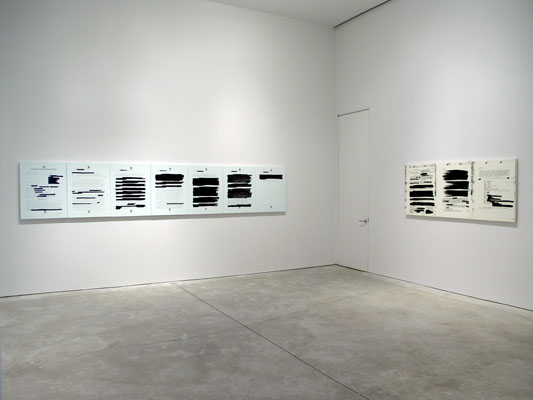
from Archive — Jenny Holzer
Coco Fusco‘s video, “Operation Atropos,” documenting the training on interrogation and resistance program she and six women went through in the woods of the Poconos, offers a political glance at the methods of physical and mental persuasion. Apart from the obviously political, the viewer realizes that this program, run by former members of the CIA, has been conceived for the private sector.
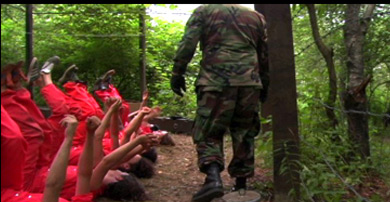
Operation Atropos
Cotter concludes his article asking, “So what kind of political art is this? It isn’t moralizing or accusatory. It’s art for a time when play-acting and politics seem to be all but indistinguishable.” They are.
It is always enormously refreshing to visit the art galleries, and to be reminded that many artists in many places, perhaps because they are faced with stark realities on a daily basis, have indeed a lot to comment. The Asian Contemporary Art Week (5/22-5/27) was one of those occasions (and still is since many galleries will continue displaying Asian art for a few more weeks.) Shilpa Gupta‘s interactive video environments at Bose Pacia offer a comment on power, militarism and imperialism. In one of the pieces the viewer sees a bucolic landscape in Kashmir and as s/he touches the screen military guards appear. Truth is indeed a fragile and many times deceiving construction.
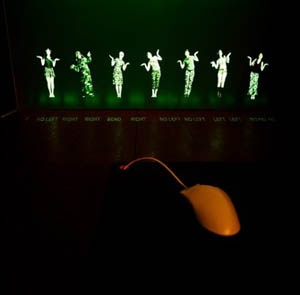
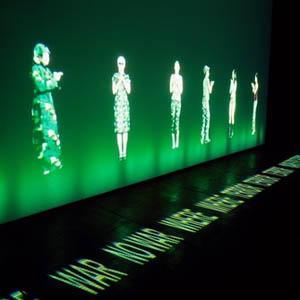
Untitled, 2005 — Shilpa Gupta
Tejal Shah‘s video installation at Thomas Erben presents the transgender community in India from within, a reality that is equally painful and celebratory. At the Sculpture Center, as part of the Grey Flags exhibition, there is a film by Apichatpong Weerasethakul the Thai filmmaker whose fresh approach to reality has taken him to use non-professional actors and improvised dialogue, offering a sober and supetcharged vision of reality in Thailand. Tilton Gallery brings together 34 contemporary Chinese artists entitled “Jiang Hu” whose literal meaning is “rivers and lakes” but that metaphorically means a place removed from the mainstream. In medieval literature it means a realm inhabited by outsiders, monks, fortune-tellers and artists who had magical powers. In the context of this exhibit that shows an interesting and disparate group, “Jiang Hu” evokes a complex reality: China an outsider within the global world.
Monthly Archives: May 2006
on collaborating with the reader
I’ve been thinking a lot about the idea of reader collaboration, prior to GAM3R TH3ORY‘s publication but to a good deal in response to its impending arrival. This notion clearly means that after the author has done one thing, the “book” becomes the accumulation of author’s and readers’ contributions.
So I’ve been thinking about collaboration. My starting point was something mentioned on my visit to the Institute — that the book’s source needs to be distributed, and it can be altered by the reader. (This is a very big idea, btw, and it’s radically altered my notion of what an e-book format’s obligations are. But that’s another discussion.)
SInce Sophie is an authoring tool, I thought, Why don’t I author something and really see what it can do? So I’ve been working with my own notion of what a book would be like that isn’t wholly limited by its medium being print. And I thought maybe I should let Sophie’s developers in on my ambition so that there’s a possibility that the features I’m envisioning might be included in the program, at least at some point in the future.
I think it’s easiest to understand my notion of collaborating with the reader by describing my work-in-progress.
So the basic notion is fairly simple, realizable already in Flash, say, or SVG:
Imagine a story, with multiple tracks. (I’m actually envisioning a short book, so let’s say 16 or 24 pages and 5 tracks.) On any page, you can go to the next or previous page. Or you can change tracks and see the next or previous page from some other track. It seems just like a 24-page book, except that the 5 tracks provide variations on what is on each page.
That’s not too exotic. And I don’t stray too far from this notion.
The first thing I’d like to do is provide multiple series of illustrations for each track. So track A might display what i call the French illustrations, or the English, or the Klee, and so on. Thus the first capability I would want to see in my authoring/reading tool is a way to change which illustration (or series of illustrations) displays within each track. You still go backwards and forwards, but maybe I like Van Gogh’s illustrations and you like Ansel Adams’. Perhaps I should mention at this point that it’s a children’s book, so I’m not casually speaking about illustrations. They are the central aspect.
The next thing I’d like to do is to allow the reader to supply illustrations, for any page (in any track), and supplant the author’s (or publisher’s) illustrations. So that perhaps my book comes with 4 series of illustrations for each track, but a reader could add many others. If these series were shared (upload your own, download others’), then perhaps you have 9 series for track A and I have 23. There has to be an easy way for the plugging in pieces, which is more on the level I’m expecting a reader to manage, as opposed to the full set of tools the author will access.
With this, the collaboration with the reader becomes two-fold — first the creation can be shared: make your own illustrations. Then, second, each individual instance becomes distinctive. If we trade “copies,” then we see the distinctive choices we each have made. Each instance is unique, especially as it contains series of illustrations that are not shared/distributed at all. In a way this reminds me of the trading card games that my ten-year-old and his friends play. They all purchase the same cards, each possessing hundreds of cards, and collect them into unique decks that they each admire and study (and then compete against, the duel being paramount). Moreover, each has some cards that none of the others has.
In addition to accepting individual illustrations or whole series of illustrations, the book should allow its text to be edited and alternate versions selected for display. I’m not sure whether one text track would be read-only, or if clicking some button would restore the text to its default form in some track, but I’d expect the author’s initial, unedited version should be retrievable in some way.
I’m far less concerned about the text than I am about this capability with illustrations, btw.
Since my project book is intended for children, I’ve thought a lot about the nature of collaboration with them. In this instance, I think will use little or no animation — it’s not an equal collaboration if the initiating author can do tricks to gain attention that the collaborating reader cannot manage. And that is one thing that makes this a book and not an animation or a cartoon and yet still strives to keep its electronicity high.
And my effort at collaboration is more like a teacher’s — here, you write/draw something, and we’ll replace what I’ve done. Perhaps in the end all the words and pictures are yours. My role was to get you started and to provide the framework. But every new collaborator can begin with the pristine master copy that anyone can access (or maybe they’ll start with a local, already altered variant that the teacher gives them). It hasn’t escaped my notice that in fact the collaboration might be between author and a class of students, not just one reader.
So. Likely as not, this first version of Sophie won’tt contain this addition/substitution capability, or perhaps not to the extent I describe. But I hope it can be added to the future feature set, or hooks anyway that will enable some plug-in to provide this capability. Because this type of collaboration seems to me to be essential.
* * *
It seems a natural expectation that a book constructed of multiple units might have multiple paths through it.
In the case of this children’s book, I don’t expect that going from track-A-page-1 to D3 to B4, and so on, is going to provide anything useful.
But I can clearly envision publications — a guidebook, a cookbook, a college course schedule, an anthology of poetry, a collection of photographs, the Meditations of Marcus Aurelius, the Sayings of the Desert Fathers — in which a reader (or a teacher) may beneficially provide paths that an author overlooks. (Each of these examples of course is an instance of wholly independent units.)
In fact, I expect that Sophie’s envisioneers have thought of such circumstances already, but I raise it here as a collateral issue — collaboration with the reader must inevitably involve everything an author touches: the text, the development of the ideas, the sequence in which they are conveyed, how they are illustrated, the conclusions drawn. In a true collaboration, the author becomes something more like a director, operating perhaps at a remove (how active will the author be in reshaping the book after its publication?). Or maybe the director analogy is too strong; perhaps it’s more like an organizer — the Merry Pranksters, Christo, Lev Waleska — who launches his/her book like a vehicle (like Voyager) and then simply rides its momentum.
Once we make the book more collaborative, we remake what it means to author a book, and the creation of a book itself may come to be something more like a play or a movie or a dance, with multiple, recognized contributors.
I’m wondering how far Sophie goes in anticipating these ideas.
so you’ve got a discussion going — how do you use it?
Alan Wexelblat has some interesting thoughts up on Copyfight about the GAM3R 7H30RY approach to writing.
Writers, particularly new ones, are often encouraged and bouyed up by physical writer’s groups, in which people co-critique works in progress. Some writing workshops/groups also include lectures from established authors and related well-known people in publishing. In SF/Fantasy, the Clarion SF&F Writers’ Workshop is well known and has graduated a number of folk who have gone on to great success.
So, can this model work online? I’m dubious. One of the things that makes a good writers’ group, and that makes Clarion the success it has been, is a rigorous screening process. You get into these things not just by having good intentions or a lot to say but by having valuable experience and insights to contribute. It’s unclear to me how one filters the mass audience of the Web into something resembling useful wisdom.
This is not a trivial question. Already, it’s all Ken can do to keep a handle on the various feedback loops spinning through the site. Separating the wheat from the chaff requires a great amount of time and attention on top of that. If we had unlimited time and resources, it would be interesting to play with some sort of collaborative filtering system for comments. What if readers had a way of advancing through a series of levels (appropriate to the game theme), gaining credibility as a respondent with each new level attained (like karma in Slashdot). These “advanced” readers would then have more authority to moderate other discussions, sharing some of the burden with the author.
On the other hand, perhaps a workshop is the wrong model. Maybe this is more like the writing of a massive wikipedia entry on games and game theory. One person writes most of it, but the audience participates in the edit and refinement process? It seems like that model might produce something more useful.
This is not headed for anything encyclopedic. Ken is still an individual voice and this book ultimately an expression of his unique critical view (the idea of writing any work of criticism collaboratively, the way one writes a Wikipedia aticle, is a little odd). But Ken is getting useful work out of his readers (who, among other things, are good at spotting typos). There’s definitely some of that wiki work ethic at play.
Another thing he’s after is good testimonials about what it feels like to play these games. We already got a fabulous little description of the experience of Katamari Damacy. Hopefully the first of many. So this is also another way of doing interviews for the book, in the setting most familiar to gamers talking about gaming: an online discussion forum.
accesselujah!!!
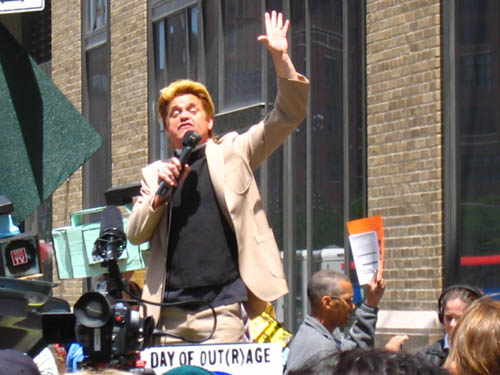
if:book took to the streets yesterday at the National Day of Out(r)age protest outside Verizon world headquarters in downtown Manhattan. Here’s Reverend Billy, a local performance artist/activist who styles himself as a televangelist (he’s sort of annoying, but entertaining in small doses). His cry: “accesselujah!”

The crowd was quite small, fenced in along a single block outside the towering Verizon building. A few handfuls of grassroots media folks and other miscellanies gathered to protest the odious COPE HR5252 legislation, which threatens net neutrality and PEG (Public, Educational and Governmental) Access channels on TV. The mission is to rally one person for every telecom/cableco lobbying dollar. Judging by yesterday’s turnout, things aren’t looking so hot.
I kinda liked this sign though:

networked books are disorienting (linear vs. shuffle)
There’s a fascinating thread active in the GAM3R 7H30RY forum discussing the format we’ve designed for reading and responding to McKenzie’s book. There’s a general sense of disorientation, as well as “hyperconsciousness” of one’s reading and commenting behaviors within the book. I take this as a positive sign that we’re pushing uncomfortably at the intersection of print and screen-based reading practices.
A particularly interesting little section:
Ray Cha: We don’t generally navigate websites in the way we read books. Perhaps, what is happening is that, because networked books are still quite new to us, we are hyper-conscious of the way we read them. Once we become more familiar with the form, the technology of the form will become more transparent to us. That is, we never think about how the interface or technology of a table of content or index of a print book works. One day, it will be the same way for the networked book.
Dave Parry: I think that is part of what I find so interesting here, this hyperconsciousness provides us with the oppurtunity to make different sorts of textual interventions, and to become aware of others that might become transparent.
McKenzie Wark: This is what both attracts me to this process and scares the hell out of me. Its the change in the material and social form that makes one aware of writing and reading as practices, but then one has this giddy sense of writing and reading without the comforting handrails of the book as form.
I think it was Victor Shklovsky who said that we become aware of structure when the roof caves in.
McKenzie composed Gamer Theory in a highly modular structure, which we ran with to the extreme in the card-based design. But emphasizing the chunks in this way — and situating it in a web browser, where people are accustomed to skipping around — we risk giving the impression that paragraphs are self-contained, or that this is a book that can be read selectively.
But this is absolutely a linear work, with an argument that builds through the successive chapters. And so naturally we find ourselves a little confused, at times needlessly debating propositions that are elucidated in subsequent paragraphs, simply because they seemed final in the context of the card. No wonder it scares the hell out of Ken, even as he dives bravely into the unknown: give people a deck of cards and they tend to shuffle it.
save the internet! protest today at verizon world hq

Today in Boston, Chicago, New York and San Francisco.
For New Yorkers today (some of us will be there):
National Day of Out(R)age – New York City Protest
Location: Verizon World Headquarters
140 West Street at Vesey Street
Date/Time: Wednesday, May 24th 12:30-1:30 (arrive 12:15)
ACE-23 trains to Chambers St.
Organized by the saveaccess.org Coalition with Fairness and Accuracy In Reporting (FAIR), NYC Grassroots Media Coalition, Paper Tiger TV and more!.
net neutrality update
1. National Day of Out(r)age 5/24/2006
Access to communication systems is vital for a functioning democracy. While there has been much activity on the issue in the blogosphere and in academic writing, the net neutrality movement has lacked a general public presence. saveaccess.org aims to put an end to that, by organizing the National Day of Out(r)age, Wednesday, May 24. With demonstrations in New York, Boston, Chicago and San Francisco, they are pushing for network neutrality, enforcing privacy of the public’s communication, telco lobby reform, and limits to the telco industry consolidation. If you care about these as we do, make your voice known.
2. What exactly are we arguing for?
On a related topic, Susan Crawford (cyberlaw expert and one of our favorite thinkers on net neutrality) gives a good definition of net neutrality on a recent blog post. Always able to keep the big picture in focus, she notes the problem with defining net neutrality as “treating all VoIP alike, all video alike, and all blogs alike,” is that someone (i.e. broadband providers) still need to look at packets. She prefers a definition where bandwidth is “treated like a utility, unbundled and open to competition, and speeds are much higher and costs are much lower.”
3. Changes to the wireless landscape are coming:
Yesterday, Crawford also linked to an article in Business Week, on the upcoming government auction of more of the wireless spectrum. New comers to wireless such as, Intel, Microsoft, TimeWarner, and News Corp have been rumored to be among the interested parties of the sale of the largest block of the wireless spectrum in history. As well, smaller entities, such as Clearwire (headed by Craig McCaw, who started McCaw Celluar and eventually sold it to AT&T) and Leap Wireless are reported to be involved. A possible result could be a re-direction of the trend of consolidation, by introducing new players with potential new services. The auction is set to start on June 29, 2006, however the effects will only be known much later.
GAM3R 7H30RY 1.1 is live!

The Institute has published its first networked book, GAM3R 7H30RY 1.1 by McKenzie Wark! This is a fascinating look at video games as allegories of the world we live in, and (we think) a compelling approach to publishing in the network environment. As with Mitch Stephens’ ongoing experiment at Without Gods, we’re interested here in a process-oriented approach to writing, opening the book up to discussion and debate while it’s still being written.
Inside the book, you’ll find comment streams adjacent to each individual paragraph, inviting readers to respond to the text on a fine-grained level. Doing the comments this way (next to, not below, the parent posts) came out of a desire to break out of the usual top-down hierarchy of blog-based discussion — something we’ve talked about periodically here. There’s also a free-fire forum where people can start their own threads about the games dealt with in the book or about the experience of game play in general. It’s also a place to tackle meta-questions about networked books and to evaluate the successes and failings of our experiment. The gateway to the forum is a graphical topic pool in which conversations float along axes of time and quantity, giving a sense of the shape of the discussion.
Both sections of GAM3R 7H30RY 1.1 — the book and the forum — are designed to challenge current design conventions and to generate thoughtful exchange on the meaning of games. McKenzie will actively participate in these discussions and draw upon them in subsequent drafts of his book. The current version is published under a Creative Commons license.
And like the book, the site is a work in progress. We fully intend to make modifications and add new features as we go. Here’s to putting theory into practice!
(You can read archived posts documenting the various design stages of GAM3R 7H30RY 1.1 here.)
the life and afterlife of vinyl records
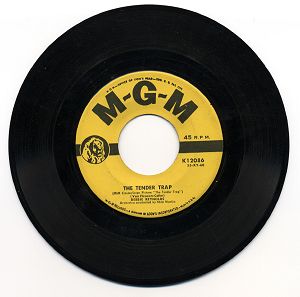
I often find myself talking to people about their relationships to books and printed matter. I wonder out loud, if we are the transitional (read: last) generation who will revere both print and screen. Because books have been the primary mode of storing and communicating knowledge for over five hundred years, we have a strong attachment to print text. The shift to from the page to the digital, and all its implications are difficult to grasp. Through these conversations, I have found that modern recorded music and especially the vinyl record, are useful cultural reference points for myself and others in understanding how media technology evolves and our preferences with it. For people born before, say the Reagan administration, they mostly likely have bought and used a variety of recorded music media, including vinyl records and audio cassette tapes. Further, they generally know people born during or after the Reagan administration who have never played, owned and even heard a LP record. This point demonstrates how we have witnessed the conversion of media technology from the analogue to the digital. Further, we can clearly see a subsequent generation who has a very different relationship to recorded music, rooted in a solely digital frame of reference.
The evolution and adoption of recorded music technology have occurred over a compressed period of time as compared to the historic primacy of the book. Early movable type was available in China in the 11th century. The invention of the printing press in the 15th century gives print a legacy that dwarfs the 20th century dominance of the vinyl record. It is not surprising that print is more entrenched in our culture. The vinyl record was able to be inexpensively mass produced, although vinyl records were fragile and their players were not easily transportable. New media technologies and formats appeared. In one case, the audio cassette tape complemented the LP, because the format and player was smaller and portable, and you could also make recordings on them. In another case of the digital CD, LPs were replaced because CDs had higher quality sound and did not scratch as easily as vinyl. We should also note that some technologies failed, such as the 8 track, which did not gain traction and faded to the background of ironic 70s pop culture references. This reminds us that we need to take each “next great” invention with a healthy bit of skepticism. Because the transitions from LPs to CDs and now to MP3s occurred in a span of twenty years, we have the benefit of living through the shifts. Therefore, the transition is less disconcerting even if its transition is not complete or fully understood. The current shift from CD to MP3 introduces us to a host of transitional issues that we will soon face with print books.
With the MP3, recorded music no longer has a physical form, just as digital text no longer embodies the physical page. Music’s transition from the analogue to the digital is far from complete. Musicians, distributors, and listeners are still adapting to the changes that going digital is causing. Musicians have new methods of recording and are experimenting with new ways reaching their audiences. Distributors of music are struggling to develop new business models in the digital, online and networked world. Listeners have a new relationship with music, now that they can access their entire music collection from an iPod. Music’s pioneering shift to the digital shows what lies ahead for the digital book in many ways. For example, we are learning from initial applications of DRM, including Apple restrictions on songs bought in the iTunes Music Store, Sony’s disastrous attempt to deploy its DRM Rootkit and Sun’s Open DRM initiatives. Some ideas will work, and some will not. These early implementations of DRM will certainly inform how it is applied to digital texts.
 |
 |
We can also see how the aspects of these older forms reappear in interesting ways. This continuity removes some of the disorientation that occurs in any period of transition. In middle school, I bought my first 45 single, the theme song from Beverly Hills Cop, “Axel F” by Harold Faltermeyer. As a format, the 45 single had its height of popularity in the 50s and 60s. In the 1970s, recording industry shifted their focus on creating and promoting album-oriented music. Today, the emergence of the MP3 music file marked the return of the single. As the preferred format for buying and downloading MP3s, tastes have cycled back to popularize the single in a digital form. Further, we maintain our nostalgia for the plastic insert that 45s required to be able to be played on LP record players. Nostalgia and forms reappearing is a common occurrence in the evolution of media.

Likewise, despite the fact that the LP is no longer as widely produced and used as it once was, it still has cultural relevance. Looking at the LP shows glimpses of a possible future for the print book in the digital age. One future of the print book, which Bob has mentioned, is the book as art object. This transformation is being foretold by the transformation of the vinyl LP as art object. The vinyl LP for newly recorded music is now a niche market. The only people I know, who still actively purchase vinyl records are DJs and indie rock purists. For the rest of us, we have moved on to CDs and MP3s. I have not owned a record player in years. However, if you go into my bedroom, you will see LPs prominently displayed. I have two (different) original “Beyond the Fringe” cast recordings of LPs hanging on my wall. Within these frames, the vinyl record is now an art object. Partially because the CD jewel box is much smaller, the LP is able to leverage its size and proportion of its record cover to maintain relevance of an cultural artifact. The Equator Bookstore in Los Angeles has taken a similar attitude towards the book. Their website explains that “all books are hand-picked by ownership and are sold in collectable condition, cleaned and wrapped in protective archival covering.” Thus, the owners are curating a collection of archival objects. They sell books as art objects, akin to the records hanging on my walls. (Although, interestingly, they also have a small publishing arm, which suggests that they are interested in publishing the book art object of the future.)
Because we have seen a radical shift in the ways people listen to music within our own lifetime, we can apply this experience to our understanding of the older, more entrenched and slower to adapt form of the book. Through this process, we see that we will maintain our attachments to older forms of media. Through nostalgia, transformation, repurposing of these beloved forms, a legacy is sustained. This occurrence should come as no surprise, as media, technology and culture has always been built upon older iterations of itself.
interactive books are closer than we think
The other day, Ben’s recent post on the “Novel Twists” and the “exquisite corpse” got us talking for a minute or two, on some children books loosely based on the “exquisite corpse.” The conversation got me reminiscing about other forms of children’s books that pushed the conventions of the book while remaining within confines of the printed page. In retrospect, as we gain clarity on the present and near future of digital books, I appreciate how for years, authors felt a need to overcome the limitations of the print book. While these books are not digital they do add interactivity to the experience, by both exploring interfaces and giving over some control to the reader.
Here is a quick run down of a few examples. (The format takes a cue from Ben’s post on the networked book.)

Mix and Match
Based on the idea of the “exquisite corpse,” these spiral bound books allow readers to combine various pages to creating their own images. In this example, the reader invents new dinosaurs, complete with remixed names. The spiral binding encourages the idea of ever turning pages. Thus, this non-linear book is not designed to be read front to back, but rather it is designed to be played with.

Pop – Up Book
My earliest memory of a pop-up book was from “Star Wars,” this gem from the late 70s is still available on ebay. Mark Hiner, a self-described “Paper Engineer” has build a great website on pop-up books, showing samples, an historical overview of pop-up books, as well as, instructions on creating your own. Pop-Up Books break the conventions of the static two dimensional page. Although, they still read linearly, pop-up books break into three dimensions, and add interactivity by including tabs to pull which create movement in a pop-up figure.
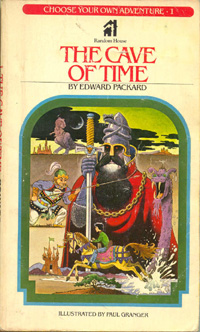
Choose Your Adventure
These pre-cursors to hyper-linked fiction were a big fad when they were first published in the late 70s and early 80s. In these books, readers are presented with the opportunity to chose the direction of the narrative. After a situation is described over a few pages, the reader is offered paths in a forking narrative. Each choice had a different page number, and the reader went to the correct page and proceeded with his selected narrative. I spent many hours reading and re-reading books from this classic series. In what was most likely my first attempt to “game the system” I recall finding an “ending” I liked, and working backwards to figure out how to get there. Reading in this way also lead to my first experience at reading a book backwards.
I have many memories of reading these kinds of books. Print books of this nature, however, are inevitably regulated to the realm of children. As I grew older and my reading became more “sophisticated,” the books I read stopped including these innovative features. In the case of fiction, pictures and illustrations were also eventually eliminated. Although, I do understand the idea that at times, visuals can become a crutch, which allow authors to become lazy with their writing. I must further admit that I was pleased to see visual representations of handwriting and letters from a “hangman” game included in David Mitchell’s Black Swan Green, a “serious” work of fiction. They were used sparingly and appropriately. Perhaps, the author felt these breaks in formalism were allowed as a special case because the book’s narrator is a thirteen year old boy.
I find it wonderfully ironic that we can look at these books for children for insight on the transition from printed page to screen, even-though these examples are still bounded by the technology of paper. By reflecting upon spiral binding, 3D pages, and hyper-linked pages, we are informed as we move further into the digital. What will the result be as mix and match books closer towards the original Surrealist game, where readers can include their own “parts?” How will pop-up books evolve with the integration of sound and video? Which hyper-linked fiction work, foreshadowed by Choose Your Adventure books, will become the first New York Times best seller?
